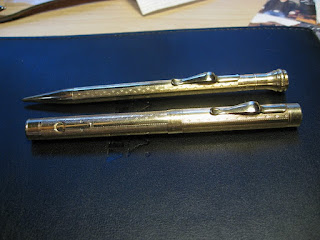Introduction
Today’s post features what is probably the smallest pen ever made: the Peter Pan pen from the Salz Brothers Pen Company. Pens we think of today as small, like the Kaweco Sport, look like giants when seen next to the Peter Pan pen.

Salz Brothers History
The Salz Brothers Pen Company was founded around 1920 in New York City by Ignatz[1], James, and Jacob Salz. Salz initially produced high quality pens, but over time the quality deteriorated. The company went out of business around 1950. Some nice examples of early Salz pens can be found at PENS PAPER INKS…WHATEVER!, including this 1920s pen and pencil set. The website also gives a brief history of the Salz Brothers Pen Company.

There is limited information available about the Salz Brothers Pen Company. Richard Binder, an extremely knowledgeable pen collector and highly respected nibmeister, has some useful information.
Worthpoint has some details on the later years of the Salz Brothers Pen Company including the name change to Stratford Pen Company.
Description

My Peter Pan pen is an early[2] model, probably from the early 1920s, and is typical of the style popular in the early twentieth century. The barrel was made of black hard rubber and overlaid with a gold filigree pattern. There is a solid area where a name could be engraved. The gold overlay on the Peter Pan was, in fact, actually gold filled, which meant that 10% of the material used for the overlay was made from 18K gold.[3]
The pen was too small to hold a lever or button filler that was typically used when this pen was made. You can see from the picture above that even a short international cartridge would have too big a diameter to fit inside the barrel, in addition to being too long.

The pen has a small ring at the top of the cap. A ribbon or chain was passed through the ring so that the pen could be worn by a woman around her neck. The pen then served a dual purpose: a writing instrument and a piece of jewelry.
The weight and size of the pen are given in the table below. The Peter Pan weighs in at ridiculously light 4 grams, or only 14% of a modern Duofold Centennial. It is interesting to see that the Kaweco Sport, which is considered a small pen today, is just about twice as long as the Peter Pan pen.
| Measurement | Units | Peter Pan | Kaweco Sport | Duofold Centennial |
|---|---|---|---|---|
| Weight | g | 4 | 9 | 29 |
| Length, capped | mm | 56 | 105 | 138 |
| Length, uncapped | mm | 53 | 100 | 127 |
| Length, posted | mm | 77 | 134 | 172 |
Details
The nib of the Peter Pan pen is usually described as a No. 1 0, that is, the smallest nib size in use.

The nib is inscribed “Peter Pan 14 KT”. As mentioned earlier, the pen is an eyedropper filler, that is, the ink is squirted into the barrel and the nib/section is screwed back into place.
I was curious about the ink capacity of the barrel, so I measured it[4]. The Peter Pan pen can hold 0.4 mL of ink. This volume is about 1/100 of an ounce. According to Wolfram Alpha, this is the equivalent of 2/3 of a plain M&M, although I imagine it’s not as tasty.

The engraving on the cap says Salz Brothers and 18 K - 1/10, which indicates that the hard rubber body is covered with a gold filled alloy.

Summary
The Salz Brothers Peter Pan pen is an example of the pens produced during the early years of the company (1920s). The materials and workmanship were of high quality, unlike the pens made during their later years. I am fortunate to have another Peter Pan pen in my collection. It differs from the one shown here only in that the gold filled exterior is solid (not a filigree pattern) so the hard rubber doesn’t show through.
It’s too bad more isn’t known about the Salz Pen Company, but I suppose that is because they only made quality pens during the first part of their existence. There would be little interest in the low quality pens made during the later years.
I can’t resist one more comparison shot:

-
Ignatz was quite a playboy and spent much of his time in nightclubs. Apparently he mixed with the wrong type of people and was shot at the entrance to his home one evening. New York Times Abstract ↩
-
The original Peter Pan pens, like this example, were superseded by increasingly larger models that were needed to accommodate non-eyedropper filling systems. ↩
-
Gold filled pens were of much higher quality than our modern gold plated equivalent. The gold doesn’t wear off as easily as gold plating, although heavy use will eventually cause brassing where the gold is worn away. ↩
-
I filled a syringe with water and noted the amount of water. I then slowly pushed down the plunger squirting water into the barrel. I stopped when the barrel was full and noted the amount of water remaining in the syringe. Subtracting this number from the original amount gave the amount of water (or ink) that was needed to fill the barrel. That number turns out to be 0.4 mL. Since a milliliter and a cubic centimeter are the same volume, this is also 0.4 cc. ↩










